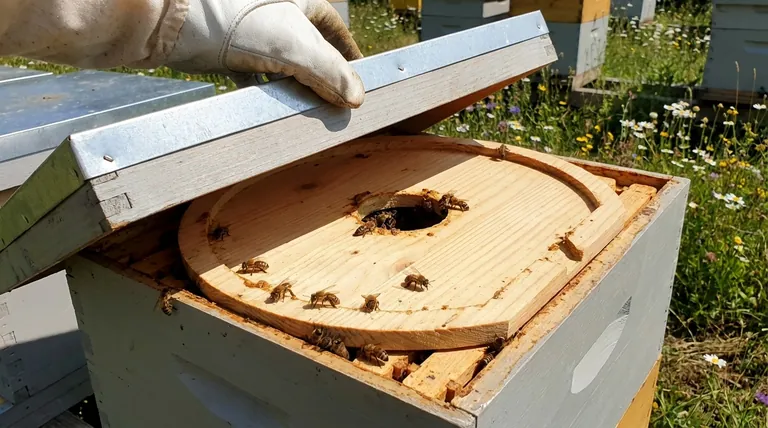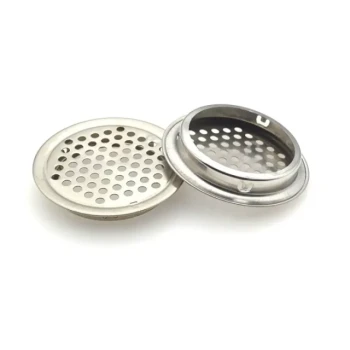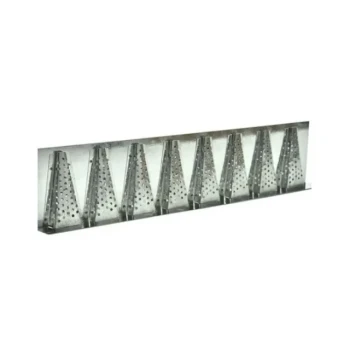In short, the inner cover is a multi-function component that sits between the top box of bees and the main, weather-proof outer cover. It is not just a simple lid; it primarily serves to make hive inspections easier, provide crucial insulation and ventilation, and offer a secondary entrance for the bees.
The inner cover is a critical interface between the colony's living space and the outside world. Its purpose is to help regulate the hive's internal environment (temperature and moisture) while simplifying essential beekeeping tasks like inspections and feeding.

The Core Functions of the Inner Cover
While it may look like a simple piece of wood, the inner cover is engineered to solve several distinct problems for both the bees and the beekeeper.
### Easing Hive Inspections
Bees instinctively seal all cracks and gaps in their hive with a sticky, glue-like substance called propolis. Without an inner cover, they would firmly cement the main outer cover directly to the top hive box.
This would make opening the hive for inspection extremely difficult, requiring significant force that would jar and distress the colony.
The inner cover acts as a sacrificial barrier. It gets propolized to the hive body, but it is much lighter and easier to remove with a hive tool. The heavy outer cover remains clean and lifts off with no effort.
### Regulating Temperature
The space between the inner cover and the outer cover creates a pocket of trapped air. This dead air space acts as a layer of insulation for the hive.
In the summer, it buffers the colony from the direct, intense heat of the sun beating down on the outer cover.
In the winter, this same air space helps reduce heat loss, allowing the bees to more efficiently maintain the critical temperature of their winter cluster.
### Managing Moisture and Ventilation
A colony of bees generates a significant amount of warm, moist air through respiration. In winter, this moisture is a major threat. If it rises and condenses on a cold outer cover, cold water will drip down onto the bees, quickly chilling and killing them.
The inner cover helps manage this moisture. It often has a small, notched rim or a central hole that provides a path for this humid air to ventilate out of the hive, preventing dangerous condensation.
### Providing an Upper Entrance
Many inner covers are designed with a small notch in the rim. When placed with this notch facing up, it creates a small upper entrance and exit.
This secondary entrance can reduce congestion at the main bottom entrance during a heavy nectar flow. It also provides a convenient exit for bees, especially when the lower entrance might be covered by snow in the winter.
### Facilitating Feeding and Harvesting
Most inner covers feature a hole in the center. This port is perfectly designed to accommodate various types of bee feeders, such as an inverted jar feeder, allowing the beekeeper to provide syrup directly above the cluster.
This same central hole is also used to place a bee escape. This one-way device is used before honey harvesting to gently clear bees out of the honey supers without causing stress or injury.
Understanding Design Variations and Common Mistakes
Properly using the inner cover requires understanding its simple but important design features. Misusing it can negate its benefits.
### The Notched Rim: Summer vs. Winter Mode
The small notch found on the rim is key to seasonal management.
For summer and general use, the inner cover is placed with the notch facing up. This creates the ventilation gap and upper entrance described earlier.
For winter, many beekeepers flip the cover so the notch is facing down. This closes the upper entrance gap to better conserve heat, while the central hole still provides a small outlet for moisture.
### Forgetting to Maintain Bee Space
The inner cover is designed to maintain proper "bee space" between it and the top bars of the frames below. If your frames are not pushed together correctly, or if the cover is warped, bees may build unwanted burr comb in the gap.
### The "No Inner Cover" Debate
Some beekeeping philosophies, particularly in warmer climates or with different hive types, may omit the inner cover. However, for the vast majority of beekeepers using standard Langstroth hives, its benefits in management, insulation, and moisture control make it a nearly indispensable component.
How to Use Your Inner Cover Effectively
Your approach to the inner cover depends on your immediate goal.
- If your primary focus is year-round hive health: Prioritize its role in buffering extreme temperatures and, most critically, managing winter moisture to keep your colony dry.
- If your primary focus is easier hive management: View it as the component that saves you from the frustrating and disruptive task of prying off a heavily propolized outer lid.
- If your primary focus is feeding or harvesting: Leverage the central hole as the dedicated and secure port for feeders and bee escapes.
Mastering the use of this simple component is a fundamental step in actively managing a healthy and productive colony.
Summary Table:
| Function | Key Benefit |
|---|---|
| Eases Inspections | Prevents bees from gluing the outer cover shut with propolis. |
| Regulates Temperature | Creates an insulating dead air space between the outer cover and the hive. |
| Manages Moisture | Provides ventilation to prevent dangerous condensation in winter. |
| Provides Upper Entrance | Reduces congestion and offers an exit if the main entrance is blocked. |
| Facilitates Feeding/Harvesting | Central hole allows for easy placement of feeders and bee escapes. |
Ready to equip your apiary with high-quality, durable inner covers and other essential beekeeping supplies?
HONESTBEE supplies commercial apiaries and beekeeping equipment distributors with the reliable, well-designed equipment needed for successful hive management. Our inner covers are built to last, helping you protect your valuable colonies and streamline your operations.
Contact HONESTBEE today to discuss your wholesale needs and discover how our products can contribute to the health of your bees and the efficiency of your business.
Visual Guide

Related Products
- Inner Beehive Cover for Beekeeping Bee Hive Inner Cover
- Professional Insulated Winter Hive Wrap for Beekeeping
- Stainless Steel Round Beehive Air Vents for Ventilation
- Professional Hive Top Bee Feeder for Beekeeping
- In-Hive Dual Compartment Frame Bee Feeder for Targeted Colony Nutrition
People Also Ask
- What is the purpose of the inner cover in a beehive? A Key to Hive Health & Easy Management
- What is the recommended orientation for the rim of an inner cover? Master Hive Ventilation and Insulation
- What is the function of an inner cover in a beehive? Essential for Hive Health & Management
- What is the role of inner covers in insulated beehives? Master Moisture Control for a Healthy Colony
- What are the advantages of using an inner cover in a beehive? Key Benefits for Hive Health & Beekeeper Efficiency



















